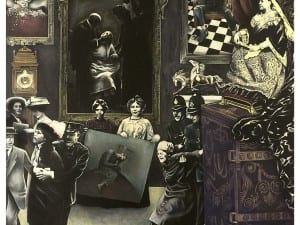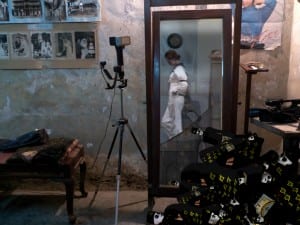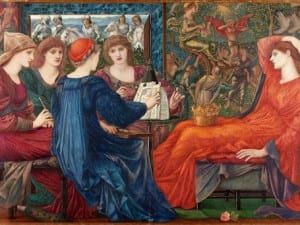Mark Bradford’s second show to date with White Cube, London, Through Darkest America by Truck and Tank is on until January 2014 and is soaked in a richly violent dialogue examining the monotonous blood vessels that unite all the vital organs of America – the highways. The title comes from the former American president Dwight D Eisenhower as he relates his experience as a member of the Transcontinental Motor Convoy of 1919. This, along with observations he made in Germany during the Second World War, led to the adoption of a nationwide highway system in the US in the 1950s. In turn however, the highways ripped and desolated communities, irreparably scarring the vast varieties of America’s landscapes.
The 9x9x9 Gallery is transformed into a claustrophobic and intimidating vice. Immediately upon entering this small square room one is subjected from all sides to the stories of ever rising works laced with Bradford’s signature aesthetic. Receive Calls On Your Cellphone From Jail (2013) is composed of multiple layers of merchant posters found in his neighbourhood in South Central Los Angeles. Each layer of poster, either black or white, is violently torn creating a volatile calligraphy transcending on through the aesthetic to reveal a deeper, darker tone: an aspect of the economic and racial demographics specific to his home, where social crisis is paralleled by commercial opportunity and exploitation. One would be hard to find an overt link between the formations of the highways system and this work, yet Bradford through accompanying text shows that his community was one of those that was affected. The physical ruptures and tension between the black and white becomes a visual metaphor for segregated communities that are left broken. The layout of the 150 canvases, in horizontal and vertical rows, resembles the geometric design of a prison cell – a commentary on the all too real consequence of those born and bred in these deprived and isolated communities.
In the South Galleries the work takes a new course, epitomising the vastness of the United States. The space is exceptionally large which in itself swamps the work, re-analysing them as isolated communities within the emptiness of the blank walls. The visual aesthetics of the works in this space are more inclined to the contours of maps and networks of communities from an aerial view. The colour pallet utilised, lends itself to reds and blues that breathe a certain life into the alluded but nondescript industrial towns born out of the highways, which over time have been over populated and swollen in size. Michigan (2013) is an elegantly formed case in example. Icy blue paper is overrun by areas of tattered white paper, squeezing the blue until it merely trickles like the beginnings of a stream that will spend centuries forging its way. Sporadic patches of red become screaming focal points that, thanks to their fiery artificial nature, could be seen as areas of dense thermal activity; perhaps smaller rural communities (given the title Michigan and its association to rural mountainous terrain). Yet Michigan’s greatest city – Detroit, Motor city itself – became the heart of America in the early 20th century as thousands upon thousands uprooted and headed north in search of the American dream, consequently revealing an abrupt and devastating decline that epitomises our understanding of darkest America.
William Davie
Mark Bradford: Through Darkest America by Truck and Tank, 16 October until 12 January, 144 – 152 Bermondsey Street, London, SE1 3TQ. whitecube.com
Credits:
1. Mark Bradford, The Rabbit Didn’t Dare, 2013. © Mark Bradford. Photo: Ben Westoby. Courtesy White Cube
2. Mark Bradford, Biting the Book, 2013. © Mark Bradford. Photo: Ben Westoby. Courtesy White Cube
3. Mark Bradford, Journal Entry#1-4, 2013. © Mark Bradford. Photo: Ben Westoby. Courtesy White Cube





